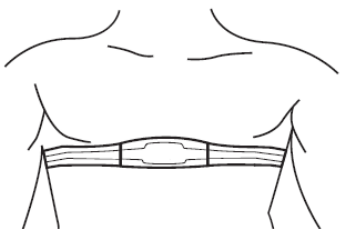National Electronics and Watch M12-317HR BLE Chest Strap Heart Monitor User Manual Manual
National Electronics & Watch Co., Ltd BLE Chest Strap Heart Monitor Manual
Manual

CE31
M12-317 User Manual (Preliminary)
Introduction
Heart rate Belt is an accessory for I-phone 4S or other devices using BLE. It will gather heart
rate signals from your body and transmit it to the phone wirelessly through BLE (Bluetooth
Low Energy version 4.0) transmission technology.
Pair your Heart Rate monitor with the phone
The HRM belt is on standby and ready to send data to your phone. Wear the belt directly on
your skin just below your breastplate. It should be snug enough to stay in place during your
run.
1) Snap the two ends of the strap around your body.
2) Wet both electrodes with a damp cloth on the back of the HRM belt. This will help create
a strong electrical connection between your chest and the HRM transmitter.
3) Wrap around the chest belt around your rib cage just below the pectoral muscles and
attach the other end of the strap to the HRM transmitter. The elastic strap should be
adjusted so that it is snug enough so that it will not move during use but not so tight as to
restrict breathing.
4) Open the NEWCO HR application in your I-Phone 4S. Tap the LINK tab to start pairing
the HR belt to the phone. For other devices, refer to the separate instruction manual on
how to link the HR belt.
5) If the heart rate data does not appear on the phone, or if you have erratic data, follow the
tips below. If the problem persists, you may have to pair the HR belt again.
5.1) Make sure the HR belt is snugly fit to your body
5.2) Reapply water, saliva, or electrode gel to the electrode of the HR belt
5.3) Clean the electrodes from possible contamination that may interfere with heart rate
signals
5.4) Wear a cotton shirt or if possible, wet your cotton shirt. Synthetic fabrics that rubs
with your skin may create static electricity and interfere with the heart rate signal
5.5) Move away from strong electromagnetic fields and other wireless sensors which can
interfere with your heart rate sensor. Possible sources of wireless interference may
include high voltage power lines, electric motors, microwave ovens, cordless phones,
and wireless LAN or access points.
FCC Statement
This equipment has been tested and found to comply with the limits for a Class B digital
device, pursuant to Part 15 of the FCC Rules. These limits are designed to provide
reasonable protection against harmful interference in a residential installation. This
equipment generates, uses and can radiate radio frequency energy and, if not installed and
used in accordance with the instructions, may cause harmful interference to radio
communications. However, there is no guarantee that interference will not occur in a
particular installation. If this equipment does cause harmful interference to radio or television
reception, which can be determined by turning the equipment off and on, the user is
encouraged to try to correct the interference by one of the following measures:
· Reorient or relocate the receiving antenna.
· Increase the separation between the equipment and receiver.
· Connect the equipment into an outlet on a circuit different from that to which the receiver
is connected.
· Consult the dealer or an experienced radio/TV technician for help.
FCC Caution: Any changes or modifications not expressly approved by the party responsible
for compliance could void the user's authority to operate this equipment.
This device complies with Part 15 of the FCC Rules. Operation is subject to the following two
conditions: (1) This device may not cause harmful interference, and (2) this device must
accept any interference received, including interference that may cause undesired operation.